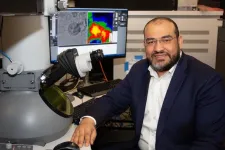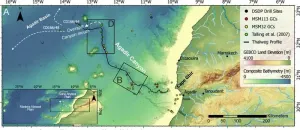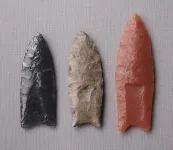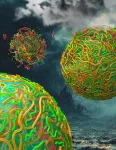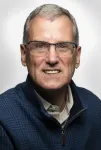(Press-News.org) ANN ARBOR—As the human population grows, more than half of Earth's land will experience an increasing overlap between humans and animals by 2070, according to a University of Michigan study.
Greater human-wildlife overlap could lead to more conflict between people and animals, say the U-M researchers. But understanding where the overlap is likely to occur—and which animals are likely to interact with humans in specific areas—will be crucial information for urban planners, conservationists and countries that have pledged international conservation commitments. Their findings are published in Science Advances.
"We found that the overlap between populations of humans and wildlife will increase across about 57% of the global lands, but it will decrease across only about 12% of the global lands. We also found that agricultural and forest areas will experience substantial increases of overlap in the future," said Deqiang Ma, lead author of the study and a postdoctoral research fellow at the U-M Institute for Global Change Biology in the School for Environment and Sustainability.
The study showed that the human-wildlife overlap will be driven by human population growth rather than climate change. That is, the increase of people settling in previously undeveloped areas will drive the overlap rather than climate change causing animals to shift where they live.
"In many places around the world, more people will interact with wildlife in the coming decades and often those wildlife communities will comprise different kinds of animals than the ones that live there now," said Neil Carter, principal investigator of the study and associate professor of environment and sustainability. "This means that all sorts of novel interactions, good and bad, between people and wildlife will emerge in the near future."
A human-driven issue
To calculate future human-wildlife overlap, the researchers created an index that combined estimates of where people are likely to populate land as well as the spatial distributions of 22,374 species of terrestrial amphibians, birds, mammals and reptiles.
They drew information about the spatial distribution of vertebrates from previously published data that forecasts where species will live based on their climatic niches. Their estimates of where people are likely to live were based on projections of economic development, global society and demographics.
"The index we created showed that the majority of global lands will experience increases in human-wildlife overlap, and this increasing overlap is the result of the expansion of human population much more so than changes in species distributions caused by climate change," Ma said.
Specifically, the researchers found that areas that currently have and are projected to have high human-wildlife overlap in 2015 and 2070 are concentrated in regions where human population density is already high, including China and India.
In addition to those places where overlap is already high, "another area of major concern are forests, particularly in forests in Africa and South America where we're seeing a large increase in the overlap in the future," Carter said. "The reason that is concerning is because those areas have very high biodiversity that would experience greater pressure in the future."
The researchers also found that median species richness—the variety of species in a given area—is projected to decrease across most forests in Africa and South America. In South America, mammal richness is projected to decline by 33%, amphibian richness by 45%, reptile richness by 40% and bird richness by 37%. In Africa, mammal richness is projected to decline by 21% and bird richness by 26%.
The need for biodiversity
Preserving biodiversity in these zones of overlap has real benefits, Carter says.
"There are cases of human-wildlife interactions that are both good and bad, but we anticipate that they're going to become more pronounced. For example, COVID19 was the result of human contact with wild animals, and there is concern that new diseases will emerge from greater encounters between people and certain wildlife species," he said. "But you also have species that provide important benefits to people, like reducing the abundances of pests."
For example, part of Ma's data analysis looked at birds that eat insects in agricultural areas and examined where those birds will go under climate change. He found that more than two-thirds of the croplands that will likely experience an increase of human-wildlife overlap by 2070 will see a decline in bird species that can help reduce crop pests.
"What we're doing is finding those areas and saying, if you have cropland or pastures here, are you going to have species move into those areas or species moving away from those areas," Carter said. "Are those new croplands or pastures going to be an additional threat to the species or could there be ecosystem services harnessed for free?"
Scavengers such as vultures and hyenas also play a critical role by cleaning waste from urban areas and other landscapes, Carter said. By clearing waste, scavengers can reduce the prevalence of some human diseases such as rabies, anthrax and bovine tuberculosis.
"Hyenas and other species that are vilified or persecuted because they are scavengers provide a lot of disease reduction benefits," Carter said. "On one hand, they're viewed as a threat, but on the other hand, they're providing free health benefits.
Equitable conservation
Future conservation strategies will have to evolve, especially in regions that previously haven't seen much human settlement, according to the researchers. In the past, a core conservation strategy was to establish protected areas where human access is restricted. This is becoming harder to implement because there are fewer such places.
"There's also a significant environmental justice argument around the validity of telling communities that may have lived in a certain area for generations that they have to move," Carter said. "Our study suggests that with more areas of the world expected to be shared both by people and wildlife, conservation planning will have to get more creative and inclusive."
Conservationists will need to engage local communities to build interest in helping improve the conservation process. This process may include establishing habitat corridors to connect existing protected areas to potentially new areas or to create temporary protected areas during critical periods for wildlife, like breeding periods, as well as other conservation innovations.
"We care a lot about which areas can support populations of endangered species, like tigers, and how human communities interact with these species," Carter said. "In some places it's going to be really hard to do everything at once: to grow crops and have urban areas and protect these species and their habitats. But if we can start planning now, we have a lot of tools to help us promote sustainable coexistence."
Co-authors of the study include Briana Abrahms of the University of Washington, U-M ecologist Jacob Allgeier, Tim Newbold of the University College London and U-M evolutionary ecologist Brian Weeks.
END
Human-wildlife overlap expected to increase across more than half of land on Earth by 2070
2024-08-21
ELSE PRESS RELEASES FROM THIS DATE:
Freeze-frame: U of A researchers develop world's fastest microscope that can see electrons in motion
2024-08-21
Imagine owning a camera so powerful it can take freeze-frame photographs of a moving electron – an object traveling so fast it could circle the Earth many times in a matter of a second. Researchers at the University of Arizona have developed the world's fastest electron microscope that can do just that.
They believe their work will lead to groundbreaking advancements in physics, chemistry, bioengineering, materials sciences and more.
"When you get the latest version of a smartphone, it comes with a better camera," said Mohammed Hassan, associate professor of physics and optical sciences. "This transmission electron microscope is ...
Study finds highest prediction of sea-level rise unlikely
2024-08-21
In recent years, the news about Earth's climate—from raging wildfires and stronger hurricanes, to devastating floods and searing heat waves—has provided little good news.
A new Dartmouth-led study, however, reports that one of the very worst projections of how high the world's oceans might rise as the planet's polar ice sheets melt is highly unlikely—though it stresses that the accelerating loss of ice from Greenland and Antarctica is nonetheless dire.
The study challenges a new and alarming prediction in the latest high-profile report from the United Nations' Intergovernmental Panel on ...
New study reveals devastating power and colossal extent of a giant underwater avalanche off the Moroccan coast
2024-08-21
New research by the University of Liverpool has revealed how an underwater avalanche grew more than 100 times in size causing a huge trail of destruction as it travelled 2000km across the Atlantic Ocean seafloor off the North West coast of Africa.
In a study publishing in the journal Science Advances (and featured on the front cover), researchers provide an unprecedented insight into the scale, force and impact of one of nature’s mysterious phenomena, underwater avalanches.
Dr Chris Stevenson, a sedimentologist from the University of Liverpool’s School of Environmental Sciences, co-led the team that for the first time has mapped a giant underwater avalanche from head ...
To kill mammoths in the Ice Age, people used planted pikes, not throwing spears, researchers say
2024-08-21
How did early humans use sharpened rocks to bring down megafauna 13,000 years ago? Did they throw spears tipped with carefully crafted, razor-sharp rocks called Clovis points? Did they surround and jab mammoths and mastadons? Or did they scavenge wounded animals, using Clovis points as a versatile tool to harvest meat and bones for food and supplies?
UC Berkeley archaeologists say the answer might be none of the above.
Instead, researchers say humans may have braced the butt of their pointed spears against the ground and angled the weapon upward in a way that would impale a charging animal. The force would have driven the spear deeper ...
Using AI to link heat waves to global warming
2024-08-21
Researchers at Stanford and Colorado State University have developed a rapid, low-cost approach for studying how individual extreme weather events have been affected by global warming. Their method, detailed in a Aug. 21 study in Science Advances, uses machine learning to determine how much global warming has contributed to heat waves in the U.S. and elsewhere in recent years. The approach proved highly accurate and could change how scientists study and predict the impact of climate change on a range of extreme weather events. The ...
The role of an energy-producing enzyme in treating Parkinson’s disease
2024-08-21
An enzyme called PGK1 has an unexpectedly critical role in the production of chemical energy in brain cells, according to a preclinical study led by researchers at Weill Cornell Medicine. The investigators found that boosting its activity may help the brain resist the energy deficits that can lead to Parkinson’s disease.
The study, published Aug. 21 in Science Advances, presented evidence that PGK1 is a “rate-limiting” enzyme in energy production in the output-signaling branches, or axons, of the dopamine neurons that are affected in Parkinson’s disease. This means that even a modest boost to PGK1 activity can have ...
Life from a drop of rain: New research suggests rainwater helped form the first protocell walls
2024-08-21
One of the major unanswered questions about the origin of life is how droplets of RNA floating around the primordial soup turned into the membrane-protected packets of life we call cells.
A new paper by engineers from the University of Chicago’s Pritzker School of Molecular Engineering (UChicago PME), the University of Houston’s Chemical Engineering Department, and biologists from the UChicago Chemistry Department, have proposed a solution.
In the paper, published today in Science Advances, UChicago PME postdoctoral researcher Aman Agrawal and his co-authors ...
Surprising mechanism for removing dead cells identified
2024-08-21
Billions of our cells die every day to make way for the growth of new ones. Most of these goners are cleaned up by phagocytes—mobile immune cells that migrate where needed to engulf problematic substances. But some dying or dead cells are consumed by their own neighbors, natural tissue cells with other primary jobs. How these cells sense the dying or dead around them has been largely unknown.
Now researchers from The Rockefeller University have shown how the sensor system operates in hair follicles, which have a well-known cycle of birth, decay, and regeneration put into motion by hair follicle stem cells (HFSCs). In a new study published in Nature, ...
UC Irvine discovery of ‘item memory’ brain cells offers new Alzheimer’s treatment target
2024-08-21
Irvine, Calif., Aug. 21, 2024 — Researchers from the University of California, Irvine have discovered the neurons responsible for “item memory,” deepening our understanding of how the brain stores and retrieves the details of “what” happened and offering a new target for treating Alzheimer’s disease.
Memories include three types of details: spatial, temporal and item, the “where, when and what” of an event. Their creation is a complex process that involves storing information based on the meanings and outcomes of different experiences and forms the foundation of our ability to recall and recount them.
The study, published ...
Study shows successful use of ChatGPT in ag education
2024-08-21
By John Lovett
University of Arkansas System Division of Agriculture
FAYETTEVILLE, Ark. — Artificial intelligence tools such as ChatGPT show promise as a useful means in agriculture to write simple computer programs for microcontrollers, according to a study published this month.
Microcontrollers are small computers that can perform tasks based on custom computer programs. They receive inputs from sensors and can be used in climate and irrigation controls, food processing systems, as well as robotic and drone applications, to name a few agricultural uses.
A recent study published with the Arkansas Agricultural ...
